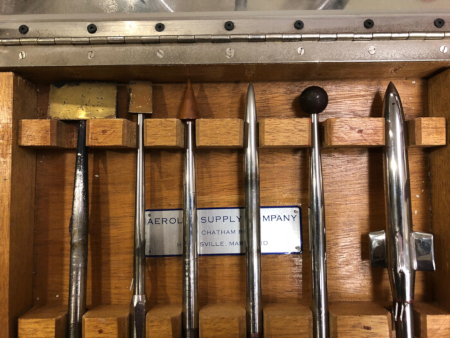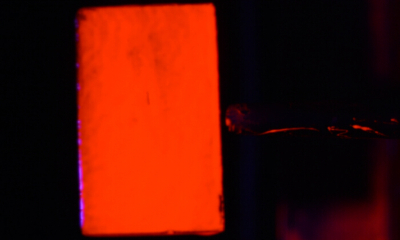Surface Dye Flow Visualization: A Qualitative Method to Observe Streakline Patterns in Supersonic Flow
Flow visualization around or on a body is an important tool in aerodynamics research. It provides a method to qualitatively and quantitatively study flow structure, and it also helps researchers theorize and verify fluid flow behavior. Flow visualization can be divided into two categories: off-the-surface visualization and surface flow visualization. Off-the-surface flow visualization techniques involve determining the flow characteristics around the body of interest. They include but are not restricted to particle image velocimetry (PIV), Schlieren imaging, and smoke flow visualization. These techniques can provide qualitative as well as quantitative data on the flow around a body. However, these techniques are generally expensive and difficult to set-up. Surface flow visualization techniques, on the other hand, involve coating the body of interest with a dye to study flow on the surface. These techniques, which are more invasive in practice, include dye flow visualization and, more recently, use pressure-sensitive paint, which gives a detailed image of the flow on the body's surface. This allows researchers to visualize different flow features, including laminar bubbles, boundary layer transitions, and flow separation. Dye flow visualization, the technique of interest in the current experiment, provides a qualitative picture of the surface flow and is one of the simplest and most cost-effective surface flow visualization methods, specifically for visualizing gaseous flows on a body.
In this experiment, the surface flow behavior on six bodies are studied in supersonic flow. The streakline patterns are obtained using the dye flow visualization technique, and the flow paths, degree of flow attachment and separation, and location and type of shocks are identified and studied from the flow images.
- Observing streaklines in supersonic flow
- Mix the fluorescent dye powder and mineral oil in a plastic bowl. Add small amounts of mineral oil to the dye in increments, mixing continuously until a semi-viscous mixture is obtained. The mixture should not be runny.
- Mount the sting above the supersonic wind tunnel test chamber and lock it into place. A blow-down supersonic wind tunnel with a 6 in x 4 in test section and an operating Mach number range of 1.5 to 4 was used in this demonstration, as show
The streakline flow patterns for the six models and conditions listed in Table 1 are shown below. For the 2D wedge, a uniform flow pattern is observed over the body, as shown in Figure 4, except in the region where there is a surface deformity, which causes the flow to separate. When angled at 12°, the flow along the surface is deflected upwards. This effect is mirrored when the model is angled at -12°. In general, all cases show attached flow across the entire
Streakline flow patterns over six bodies in supersonic flow were studied using surface dye flow visualization. Flow patterns over the 2D and 3D wedges showed that tip effects play a dominant role in determining surface flow structure. Flow over the cone was shown to be fully attached for a deflection range of ±13°. The blunt nose model was the first body to show a clear separation line when deflected at an angle of 11°, a pattern that was also observed in the initial section of the missile. The flow patter
Pular para...
Vídeos desta coleção:

Now Playing
Surface Dye Flow Visualization: A Qualitative Method to Observe Streakline Patterns in Supersonic Flow
Aeronautical Engineering
4.8K Visualizações

Desempenho Aerodinâmico de um Aeromodelo: O DC-6B
Aeronautical Engineering
8.1K Visualizações

Caracterização da hélice: variações no passo, diâmetro e número de pás no desempenho
Aeronautical Engineering
26.0K Visualizações

Comportamento do aerofólio: Distribuição de pressão sobre uma asa Clark Y-14
Aeronautical Engineering
20.8K Visualizações

Desempenho da asa Clark Y-14: Implantação de dispositivos de alta sustentação (Flaps e Slats)
Aeronautical Engineering
13.2K Visualizações

Método da esfera de turbulência: avaliando a qualidade do fluxo do túnel de vento
Aeronautical Engineering
8.6K Visualizações

Fluxo Cilíndrico Cruzado: Medição da Distribuição de Pressão e Estimando os Coeficientes de Arrasto
Aeronautical Engineering
16.0K Visualizações

Análise de bocais: variações no número de Mach e na pressão ao longo de um bocal convergente e convergente-divergente
Aeronautical Engineering
37.7K Visualizações

Imageamento de Schlieren: uma técnica para visualizar recursos de fluxo supersônico
Aeronautical Engineering
11.2K Visualizações

Visualização de fluxo em um túnel de água: observando o vórtice de ponta sobre uma asa delta
Aeronautical Engineering
7.8K Visualizações

Tubo Pitot-estático: um dispositivo para medir a velocidade do fluxo de ar
Aeronautical Engineering
48.4K Visualizações

Anemometria de temperatura constante: uma ferramenta para estudar o fluxo em camada limite turbulenta
Aeronautical Engineering
7.1K Visualizações

Transdutor de Pressão: Calibração Usando um Tubo Pitot-estático
Aeronautical Engineering
8.4K Visualizações

Controle de Voo em Tempo Real: Calibração de Sensor Incorporado e Aquisição de Dados
Aeronautical Engineering
10.0K Visualizações

Aerodinâmica de Multicópteros: Caracterizando o Empuxo em um Hexacóptero
Aeronautical Engineering
9.0K Visualizações
Copyright © 2025 MyJoVE Corporation. Todos os direitos reservados


